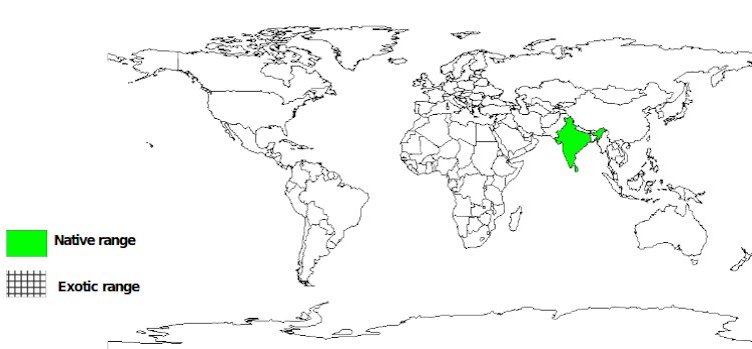Publication
from Agroforestree Database: a tree reference and selection guide
version 4.0
by C. Orwa, A. Mutua, R. Kindt, R. Jamnadass and S. Anthony
Feronia
limona (L.) Swingle
Local Names:
Bengali (kait,
kath bel, bela); Burmese (thibin, thanatka); English (elephant apple,
wood-apple, monkey fruit, curd fruit); French (pomme de bois, citron
des mois, pomme d'elephant); Hindi (bilin, kait, kaitha, bhenta,
katbel, kavitha, nayi bel); Indonesian (kusta, kawista); Lao
(Sino-Tibetan) (ma-fit); Malay (gelinggai, belinggai); Tamil (velam,
velan, vila, vilanga); Thai (ma-khwit); Vietnamese (cân thâng)
Family:
Rutaceae
Botanic
Description
Feronia
limonia is a
deciduous, slow-growing, erect tree with a few upward- reaching
branches bending outward near the summit where they are subdivided into
slender branchlets drooping at the tips. Bark ridged, fissured and
scaly; spines sharp, 2-5 cm long on some of the zigzag twigs.
Leaves
alternate, 7.5-12.5 cm long, dark-green, leathery, often minutely
toothed, blunt or notched at the apex, dotted with oil glands and
slightly lemon-scented when crushed.
Flowers dull-red or greenish, to 1.25 cm wide, borne in small, loose,
terminal or lateral panicles.
Fruit
round to oval, 5-12.5 cm wide, with a hard, woody, greyish-white,
scurfy rind about 6 mm thick, pulp brown, mealy, odorous, resinous,
astringent, acid or sweetish, with numerous small, white seeds
scattered through it.
Feronia
is a monotypic genus in the family Rutaceae. There are 2 forms, one
with large, sweet fruits and the other with small, acid fruits.
Biology
Flowers normally
bisexual. In Malaysia, leaves are shed in January, flowering occurs in
February and March, and the fruits mature in October and November. In
India, the fruits ripen from early October through March. Seedlings
will not bear fruit until at least 15 years old.
Ecology
The wood-apple is
native and common in dry plains. It prefers a monsoon climate with a
distinct dry season. The tree grows up to an elevation of 450 m in the
western Himalayas.
Biophysical
Limits
Altitude: 0-450 m, Mean annual rainfall: 800-1 200 mm, Mean annual
temperature: 20-29 deg. C
Soil types: Throughout its range there is a diversity of soil types,
but it is best adapted to light soils.
Documented
Species Distribution
Native:
India, Sri Lanka
Exotic: Malaysia

The
map above shows countries where the species has been planted. It does
neither suggest that the species can be planted in every ecological
zone within that country, nor that the species can not be planted in
other countries than those depicted. Since some tree species are
invasive, you need to follow biosafety procedures that apply to your
planting site.
Products
Food:
The rind must be cracked
with a hammer. The scooped-out sticky pulp, is eaten raw with or
without sugar, or is blended with coconut milk and palm-sugar syrup and
drunk as a beverage, or frozen as an ice cream. It is also used in
chutneys and for making jelly and jam. The pulp represents 36% of the
whole fruit. The pectin content of the pulp is 3- 5% (16% yield on
dry-weight basis) and has potential for multiple uses. Seeds contain
bland, non-bitter, oil high in unsaturated fatty acids.
Fodder:
The tree is lopped for fodder.
Fuel: The wood serves as fuel.
Timber:
Wood is yellow-grey or whitish, hard, heavy, durable, and valued for
construction, pattern-making, agricultural implements, rollers for
mills, carving, rulers, and other products.
Gum or resin:
The trunk and branches exude a white, transparent gum; especially
following the rainy season utilized as a substitute for, or adulterant
of gum arabic, and also in making artists' watercolors, ink, dyes and
varnish. It consists of 35.5% arabinose and xylose, 42.7% d-galactose,
and traces of rhamnose and glucuronic acid
Medicine: The fruit is used
in India as a liver and cardiac tonic, and when unripe, as an
astringent means of halting diarrhoea and dysentery and effective
treatment for hiccough, sore throat and diseases of the gums.
The
pulp is poulticed onto bites and stings of venomous insects, as is the
powdered rind. Juice of young leaves is mixed with milk and sugar candy
and given as a remedy for biliousness and intestinal troubles of
children.
The powdered gum, mixed with honey, is given to overcome dysentery and
diarrhea in children.
Oil derived from the crushed leaves is applied on itch and the leaf
decoction is given to children as an aid to digestion.
Leaves,
bark, roots and fruit pulp are all used against snakebite. The spines
are crushed with those of other trees and an infusion taken as a remedy
for menorrhagia. The bark is chewed with that of Barringtonia and
applied on venomous wounds.
Other products:
The heartwood contains ursolic acid and a flavanone glycoside,
7-methylporiol-D-xylopyranosyl-D- glucopyranoside. The unripe fruits
contain 0.015% stigmasterol. Leaves contain stigmasterol (0.012%) and
bergapten (0.01%). The bark contains 0.016% marmesin. Root bark
contains aurapten, bergapten, isopimpinellin and other coumarins.
Services
Ornamental: F. limonia
is planted as a roadside tree near villages.
Boundary or barrier or support: The tree is cultivated along field
boundaries.
Further
Reading
CABI. 2000. Global Forestry Compendium. CD-ROM. CABI
Gupta
VC, Hussain SJ and Imam S. 1997. Important folk-medicinal plants and
traditional knowledge of tribals of Aurangabad and Nasik forest
divisions of Maharashtra, India. Hamdard Medicus. 40: 59-61.
Hossain M, Biswas BK, Karim MR, Rahman S, Islam R and Joarder OI. 1994.
In vitro organogenesis of elephant apple (Feronia limonia).
Plant Cell, Tissue and Organ Culture. 39: 265-268.
Morton J. 1987. Wood-Apple. p. 190-191. In: Fruits of warm climates.
Julia F. Morton, Miami, FL.
Singh
UV. 1996. Conservation of forest genetic resource - an ex-situ
management of secondary forests. Indian Forester. 122(9): 787-794.
|
|
